County: Wexford Site name: COOLNABOY, CO. WEXFORD
Sites and Monuments Record No.: N/A Licence number: E1181
Author: MARY CAHILL
Site type: Early Bronze Age graves
Period/Dating: —
ITM: E 700858m, N 631848m
Latitude, Longitude (decimal degrees): 52.428815, -6.516912
Introduction
In February 1988 a pit containing a cremation and two vessels was discovered after the collapse of a small quarry face at Coolnaboy, near Oilgate, Co. Wexford. The site was reported to the NMI by Ms Geraldine Stout of the National Monuments Service, who had been contacted by Mr Nicky Furlong. The pit and its contents had been noticed by Mr Danny Parker, Coolnamain, Oilgate, a neighbour of Mr John Bolger, the landowner. The sandpit was used from time to time soil, which had subsequently collapsed, revealing the burial. A rescue excavation was undertaken by Mary Cahill and the human remains were examined by Barra Ó Donnabháin.
Location (Fig. 3.212)
The site was in a sandpit in the townland of Coolnaboy, near Wexford town, south-east Co. Wexford.353 It was 1km north-east of Oilgate and 3km east of the River Slaney, at an altitude of 50m above sea level. Approximately 6km south of Coolnaboy, in Deeps townland, a short cist containing a vessel was found in 1951.
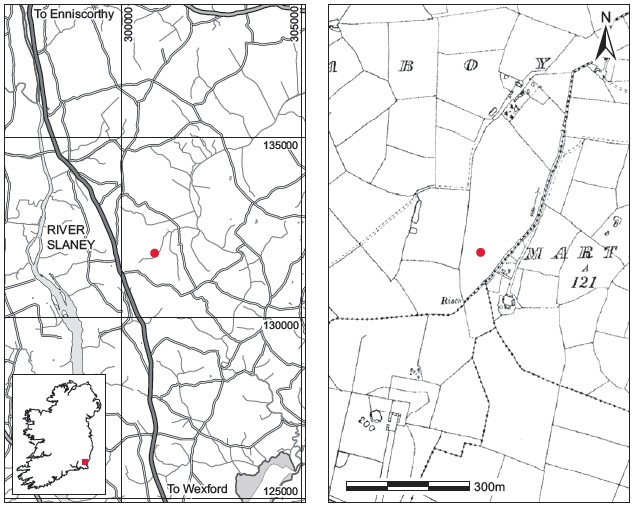
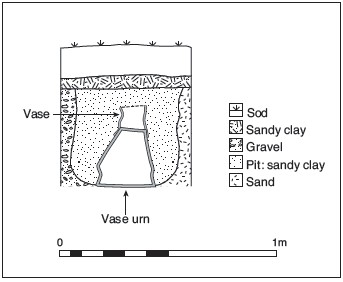
Description of site
The pit lay approximately 0.2m below ground level. It was a simple U-shape in section, approximately circular in plan, measuring 0.45m deep by 0.5m in maximum width (Fig. 3.213). It was cut into the sand and did not appear to have been lined with a different material.
The pit contained a cremation of an adult individual (1988:20), possibly male, contained within an inverted vase urn, and a small vase placed, inverted, on the base of the urn. The main cremation deposit and a small fragment of a bronze pin were contained within the vase urn, while some small fragments of bone were found in the fill of the vase. The vase was in very poor condition owing to the pressure of earth above it. Remains of its collapsed base rested on the base of the vase urn. Owing to the condition of the sandpit face it was extremely difficult to recover the vessels. The vase had to be removed in sherds as a result of its condition. The vase urn was already severely damaged on the side that was exposed in section but was removed on a board and remained intact. The fill of the pit was of a uniform sandy clay mix consistent with the local soil. No other features were noted.
Pottery
Vase urn, 1988:17 (Fig. 3.214)
Vase urn, decorated with incised lines and chevrons. The neck of the vessel is decorated internally and externally with incised horizontal lines. The rim is decorated internally and externally with short oblique strokes. Below the neck and defining the shoulder is a thin band of horizontal decoration, which consists of incised chevrons bordered above and below by incised horizontal lines. The body of the vessel is decorated with a thick band (approximately 11cm wide) of incised decoration, which consists of vertical incised lines alternating with vertically disposed incised chevrons. The final band of decoration consists of more widely spaced horizontal lines.
Dimensions: H 18.6cm; D rim 21cm; T rim 7cm; D base 11cm; T base 1.2cm
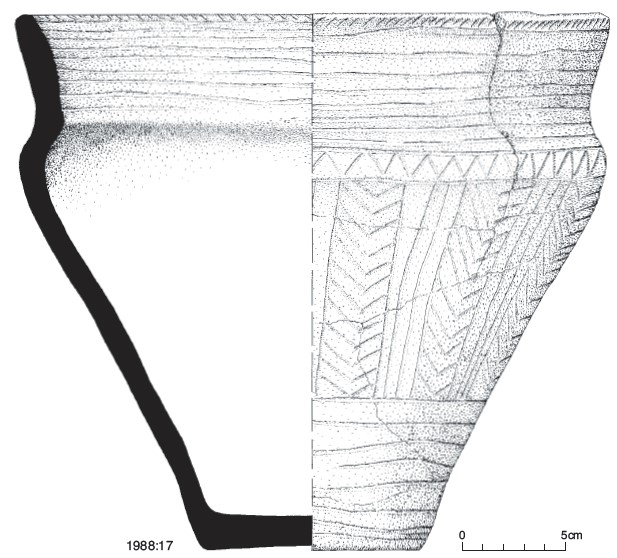
Bipartite vase, 1988:18 (Fig. 3.215)
This vase is decorated with impressed and incised decoration. The inner side of the neck was decorated with vertically disposed comb impressions, bordered above and below by impressed triangles. The neck is decorated with a horizontal band of false-relief bar chevrons bordered by impressed comb decoration. This false relief panel, bordered by comb impressions, is continued to approximately halfway down the outer side of the vessel, where it then changes to incised decoration consisting of lattice, herringbone and horizontal incised lines.
Dimensions are estimated as the vessel is fragmentary: H 15.85cm; D rim 15.4cm; D base 8.8cm; max. D of body 15.7cm.
Burnt(?) bronze pin(?), 1988:19 (Fig. 3.215)
Lower part of stem of pin, rectangular in section, narrowing towards a flattened point. The piece is bent and twisted.
Dimensions: L 3.4cm; T 0.3cm by 0.25cm; W of flattened strip 0.27cm
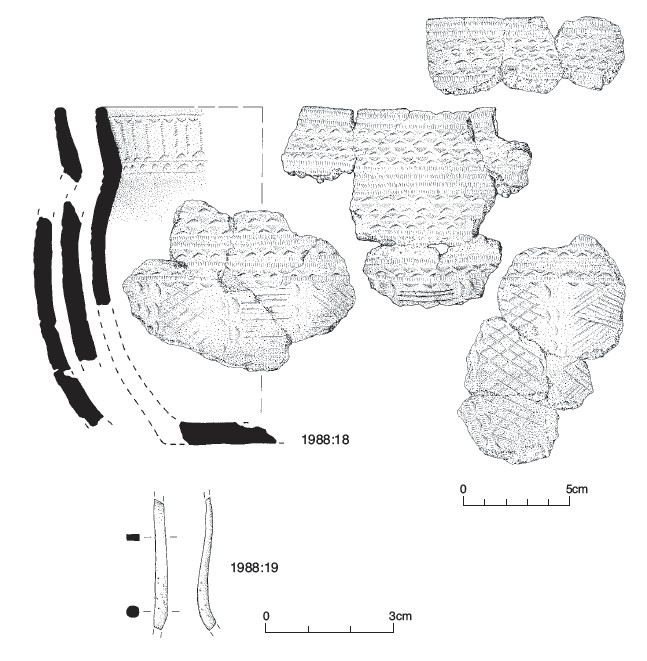
Comment
Two samples of charcoal from the deposit were dated to 3850±70 BP and 3420±140 BP. A third sample from cremated bone yielded a date of 3620±50 BP,354 which calibrates to 2140–1786 BC. Brindley (2007, 94) notes that both charcoal dates were affected by technical problems but also confirms that the carbonate date is within the expected range. In discussing the typology of vases and vase urns, Brindley (2007, 259) places the vase in stage 2 of the development of vases, between c. 1930/20 BC and c. 1830 BC. In discussing the development of vase urns the Coolnaboy vessel is placed also in stage 2, both stages being broadly contemporary. The vase was placed mouth downwards over the upturned base of the vase urn, which is an unusual placement of vessels.
HUMAN REMAINS
BARRA Ó DONNABHÁIN
Introduction
Burial 1988:20 contains 1,382.2g of cremated human bone. The deposit consists of about 2,500 fragments of bone. All of the remains have the grey/white colour characteristic of calcined bone. A few fragments have some green/blue staining that is consistent with copper staining. The deposit seems to contain the remains of one individual. Most fragments average 30–40mm in length, though many are over 80mm long. The largest fragment has a maximum length of 129.72mm (a portion of the femoral shaft).
Age and sex
The right temporal mastoid process was recovered. Its size and shape are suggestive of a male individual. The occipital squama is also present and there is no trace of a nuchal crest. The head of the right femur was also retrieved and it is small and gracile. Given the evidence of intense burning (below), this may be the result of shrinkage. While this evidence is somewhat equivocal, the overall impression created is that this was a male individual, although this is stated with diffidence.
Two fragments of the face of the pubic symphysis were found. These, combined with the state of fusion of the endocranial sutures, suggest that this was a middle-aged or possibly older adult (i.e. at least 30–35 years old).
Teeth
Surviving portions of alveolar bone indicate that the following teeth were present and fully
erupted at the time of death:

The remaining tooth positions are not available for inspection.
Pathology
The articular surfaces of some long bones were recovered. None has any evidence of osteoarthritis. Mild osteophytic lipping occurs on the centra of at least four thoracic and/or lumbar vertebrae, including L5. None of the observable posterior vertebral joints has evidence of osteoarthritis. Fragments of at least eleven ribs are present. Five are from the left side and six are from the right. Of the eleven lateral rib articulations available for inspection, one has lipping indicative of osteoarthritis. None of the six medial rib articulations has evidence of degenerative changes. The occurrence and severity of this disorder in this individual are not unusual for an adult.
Table 3.130—Weights of identified fragments and their percentage of the identified total.
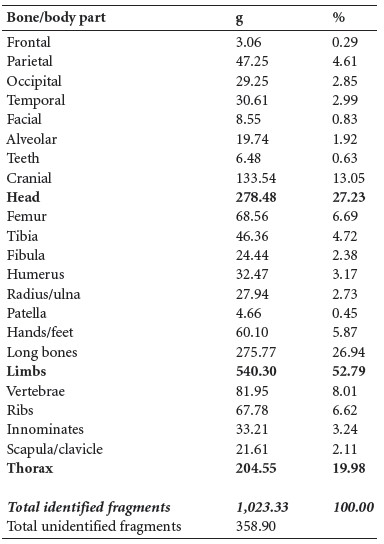
Firing and retrieval of remains
These remains were very well burnt. All bones recovered were fully calcined. The degree of combustion achieved is consistent with the burning of a fully fleshed corpse. Many fragments have an exaggerated degree of distortion and warping. This might be due to the effects of the weight of pyre material on the bone, perhaps indicating that the body was placed underneath the pyre rather than on top of it or in the middle.
After the cremation, the retrieval of burnt remains was comprehensive. Portions of most skeletal elements are present in the deposit, including sesamoid bones and many of those of the wrists and feet. This can be seen in Table 3.130, which lists the weights of identified fragments and their proportions of the identified total.
The large size of many of the bone fragments suggests that these remains were not deliberately crushed after their collection.
REPORT ON THE SOURCE OF POTTERY CLAY
J.S. JACKSON
Fragments in the pottery include (i) small pebbles of milky and clear quartz (about 6mm in diameter), (ii) crushed fragments of quartz of both the foregoing varieties, (iii) angular fragments of felsite up to 6mm in diameter, (iv) small grains of vein quartz, very rounded and about 0.2mm in diameter, and (v) quite large fragments of basaltic rock. The limited number of fragments, grains or pebbles that can be identified indicates:
1. provenance from a volcanic area, such as the Enniscorthy–Oilgate area with its suite of Caradocian volcanics;
2. that the material is (a) partly water-transported and water-worn pebbles or grains, either fluviatile (from a river) or glacio-fluvial (from meltwaters from an ice-front), and (b) partly deliberately crushed from larger pebbles, etc. The material is therefore part crushed and part original and the source could be quite Local.355
353. Parish of Edermine, barony of Ballaghkeen. WX032-042——. IGR 300930 131800.
354. GrN-15964; GrN-16820; GrA-14610.
355. Dr Jackson also reported on a ‘hollowed stone’, which he concluded was natural.